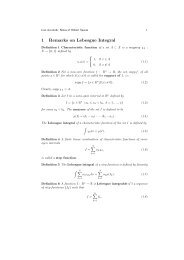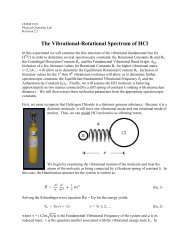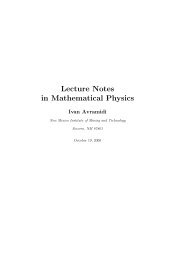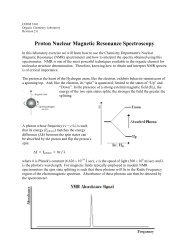A Magnetic α Ï Dynamo in Active Galactic Nuclei Disks - NMT Physics
A Magnetic α Ï Dynamo in Active Galactic Nuclei Disks - NMT Physics
A Magnetic α Ï Dynamo in Active Galactic Nuclei Disks - NMT Physics
You also want an ePaper? Increase the reach of your titles
YUMPU automatically turns print PDFs into web optimized ePapers that Google loves.
– 23 –VP is pleased to thank Richard Lovelace and Eric Blackman for helpful discussions. EricBlackman is thanked aga<strong>in</strong> for his support dur<strong>in</strong>g the late stages of this work. SC particularlyrecognizes Hui Li of LANL for support through the Director funded Research on the MagnetizedUniverse and New Mexico Tech for support of the plume rotation experiments as well as thedynamo experiment. The facilities and <strong>in</strong>teractions of Aspen Center for <strong>Physics</strong> dur<strong>in</strong>g two summervisits by VP and more by SAC are gratefully acknowledged. This work has been supportedby the U.S. Department of Energy through the LDRD program at Los Alamos National Laboratory.VP also acknowledges partial support by DOE grant DE-FG02-00ER54600 and by theCenter for <strong>Magnetic</strong> Self-Organization <strong>in</strong> Laboratory and Astrophysical Plasmas at the Universityof Wiscons<strong>in</strong>-Madison.A. Parameters of Shakura–Sunyaev DiskIn the subsequent estimates of the disk physical parameters we will keep the radius of the diskr, where the star-disk collisions happen, Shakura–Sunyaev viscosity parameter α ss , ratio of the disklum<strong>in</strong>osity to the Edd<strong>in</strong>gton lum<strong>in</strong>osity l E , fraction ǫ of the rest mass accretion flux Ṁc2 , which isradiated away, as parameters. We will assume them to be with<strong>in</strong> an order of magnitude from theirtypical values of importance for the dynamo problem, which are the follow<strong>in</strong>gα ss = 0.01, l E = 0.1, ǫ = 0.1, r = 10 −2 pc. (A1)The flux of the stars through the disk, nv/4, peaks at the radii <strong>in</strong>side r = 10 −2 pc (see section 3.2),therefore we need to know the physics of the accretion disk at r ∼ 10 −2 pc. Below, we will def<strong>in</strong>ethe gravitational radius as r g = 2GM/c 2 = 3.0 · 10 13 M 8 cm = 9.5 · 10 −6 M 8 pc. All formulae forthe structure of Shakura–Sunyaev disk are written for an arbitrary value of the black hole massM = 10 8 M 8 M ⊙ . However, we will consider only M = 10 8 M ⊙ whenever we <strong>in</strong>voke the model forthe star distribution <strong>in</strong> the central cluster, because the best available model of the central starcluster was calculated for the M = 10 8 M ⊙ (section 2.1). F<strong>in</strong>ally, the accuracy of expressions forthe disk parameters is only one significant figure <strong>in</strong> all cases, and we keep two or even three figuresonly to avoid <strong>in</strong>troduc<strong>in</strong>g additional round off errors, when us<strong>in</strong>g our expressions. Similarly, oneshould not be concerned about small jumps of values across the boundaries with different physicalapproximations: a more elaborate treatment is needed to f<strong>in</strong>d exact match<strong>in</strong>g solutions there,although the physical pr<strong>in</strong>ciples are unchanged.We use formulae from the Shakura & Sunyaev (1973) article to obta<strong>in</strong> estimate of the state ofthe accretion disk. We assume the Schwarzschild black hole with the <strong>in</strong>ner edge of the disk be<strong>in</strong>gat 3r g . However, s<strong>in</strong>ce we consider star-disk collisions happen<strong>in</strong>g at ∼ 10 3 r g , general relativisticcorrections are only at a level less than few per cents and do not matter for our approximatetreatment of star-disk collision hydrodynamics. All expressions for disk quantities below were alsoverified <strong>in</strong> later textbooks by Shapiro & Teukolsky (1983) and Krolik (1999).The <strong>in</strong>ner part of the disk (part (a) as <strong>in</strong> Shakura & Sunyaev (1973)) is radiation dom<strong>in</strong>ated
















